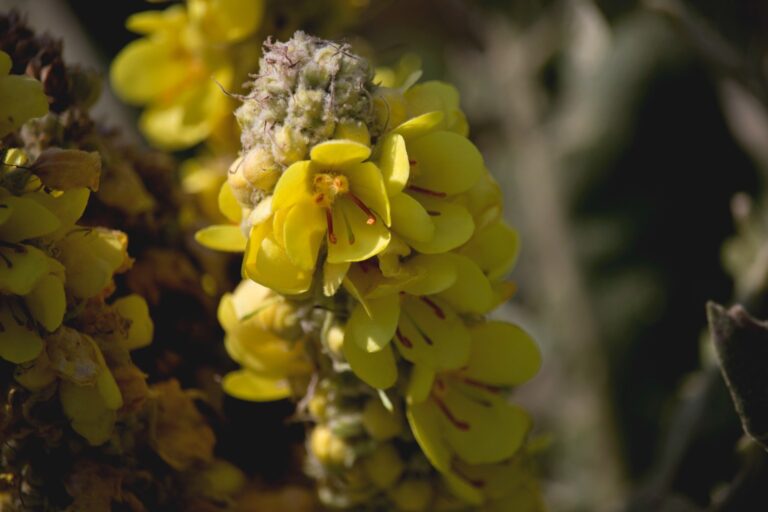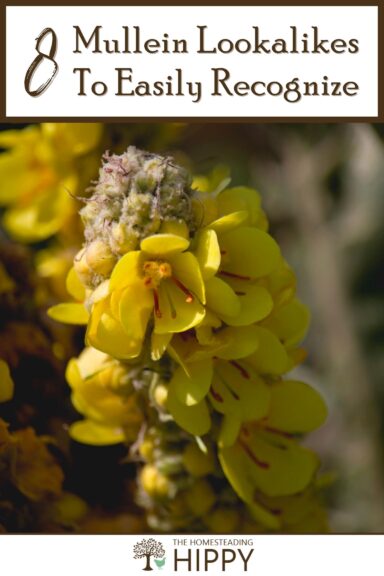Mullein, also known as common mullein, is a plant that isn’t native to North America, but since its introduction it has spread explosively, and is commonly viewed as an invasive weed in agricultural fields.

Despite this, mullein is a plant with many beneficial properties, and one that has long been used in various traditional medicines and even for various crafts.
And whether you love it or hate it, it’s important to know that there are many mullein look-alikes out there in the world, some of them likewise helpful or aggravating at times, and some of them dangerous!
Keep reading, and I’ll tell you about the 8 mullein lookalikes and how to easily recognize them…
Table of Contents
1. Lamb’s Ear (Stachys byzantina)
Lamb’s Ear, Stachys byzantina, is commonly confused for Common Mullein due to its similar velvety and notably tongue-shaped leaves.
But this evergreen perennial is grown primarily for its rich and showy, silvery foliage which forms a dense clump of thick foliage that spreads rapidly when it is grown in favorable conditions.
Lamb’s Ear also produces spikes of purple or pink flowers, adding to its visual appeal.
Native to the Middle East, Lamb’s Ear thrives particularly well in dry and poor soils, but its resilience and unique texture make it an inspired choice for ornamental gardens worldwide and so it can be found growing wild pretty much all over- a lot like mullein!
Lamb’s Ear is completely safe to handle, something many people like to do thanks to those soft, suede-like leaves.
And, fun fact, Lamb’s Ear leaves have historically been used as bandages during ancient times due to their absorbent nature, toughness and pliability.
2. Water Lettuce (Pistia stratiotes)
Water Lettuce, or Pistia stratiotes, could by appearances only be confused with Common Mullein, especially when observed from a distance, but its growth environment will dispel the mistake quickly: as the name suggests, it grows in the water!
Or rather on top of the water’s surface, but still. This aquatic plant has light green, velvety leaves that look much like a lettuce head.
Native to Africa, this free-floating perennial is now found all over the globe, typically in still or slow-moving bodies of water.
It’s known for its rapid growth and ability to cover large areas of water, which can sometimes lead to it being considered an invasive species.
Handling Water Lettuce is generally safe, but it’s important to remember that it’s dangerous if ingested by mammals because it has calcium oxalate which can cause tissue burns!
It will, though, clean any water source you plant it in, though many fish can damage it by nibbling on it, so be warned!
3. Corn Lily (Veratrum californicum)
An erect, unbranched perennial herb that grows between 3 and almost 7 feet tall, primarily native to California and other parts of western North America.
Corn Lily thrives in quite moist soil and can cover large areas in favorable conditions, where it bears large, conspicuously pleated, oval leaves that add to its visual appeal.
The Corn Lily could be confused for Common Mullein due to its tall, leafy stalks that likewise resemble a cornstalk (hence the name).
However, don’t let its innocent beauty fool you: This plant is also known as False Hellebore and can cause severe poisoning in sheep, and is likewise dangerous for human consumption as well.
That’s because it contains a teratogenic alkaloid toxin called cyclopamine, a poison that can infamously cause various congenital defects.
Admire this imperious plant from a safe distance, and be especially cautious if it is growing among your mullein!
4. Hens-and-Chicks (Sempervivum tectorum)
Hens-and-Chicks, scientifically known as Sempervivum tectorum, shares a similar growth pattern to young Common Mullein, but it’s distinctive in a way that has given the plant its name.
Though it is an only-low growing plant, it also forms clusters of rosettes, the larger parent rosettes are the “hens,” and the smaller rosettes that spring from them are the “chicks”.
A hardy perennial that’s native to Europe and widely cultivated in other regions, Hens-and-Chicks is quite adaptable and can thrive in poor soils and dry conditions.
And luckily, Hens-and-Chicks is entirely safe to handle and even beneficial. It’s often used in rock gardens, on rooftops, and in wall crevices for its ornamental appeal.
You can cultivate hens-and-chicks as a decorative plant for its own sake, or use its spreading nature as a ground cover for smaller areas.
5. Evening Primrose (Oenothera biennis)
You may mix up the Evening Primrose, Oenothera biennis, with the common mullein due to their highly similar flowers, though that’s where the similarities end.
The foliage of these two plants is totally different! The evening primrose is characterized by leafy, branched stems from a basal rosette, with bright-yellow, four-petaled flowers that can be up to 2 inches across.
But unlike the common mullein, these flowers open at night, a distinguishing feature you can easily look out for.
This is another plant that is predominately safe to touch, and one that was long used by Native Americans both for food and medicinal purposes, treating everything from skin ailments to high blood pressure and other maladies.
6. African Violet (Saintpaulia ionantha)
Native to Tanzania and Kenya, the African Violet is a popular indoor plant loved for its vibrant, purple flowers.
The plant has dark green, rounded leaves that are covered in fine hairs, giving them a fuzzy texture similar to that of the common mullein.
At first glance or in the case of young plants, you might easily mistake the two because of the similarity of the leaves. However, as soon as the flowers bloom you can tell them apart instantly.
Unlike the mullein, At first glance, you might mistake the African violet (Saintpaulia ionantha) for the common mullein because of their thick, fuzzy and velvetine leaves.
However, as soon as the flowers bloom you can tell them apart instantly by the pink, purple, blue, red or white petals.
Also unlike common mullein, African violets are small, typically growing only 2 to 6 inches in height.
Because African violets prefer a warm climate and indirect light, and also because they are so space-efficient, you might find them highly suitable for indoor cultivation.
They’re also a favorite among green thumbs for their tendency to flower all year round!
Even better, they are non-toxic for adults, kids and pets, so if you’re looking for a small, vibrant plant to brighten up your home, the African violet is an inspired choice!
7. Common Comfrey (Symphytum officinale)
This plant is often found in damp, grassy meadows, alongside rivers, in ditches, along roadsides and other “waste” ground.
Common comfrey is sometimes mistaken for the common mullein due to similar growth patterns and overall leaf structure.
Common comfrey also spreads vigorously, forming clumps of long, elliptical, emerald-green leaves which are hairy. Each leaf can grow up to 10 inches long, giving the plant a robust and stocky appearance.
But unlike the common mullein, the common comfrey has bell-shaped flowers that can be various shades of purple, pink, or white.
And here’s an intriguing piece of trivia about common comfrey: the scientific name, Symphytum, comes from the Greek words symphyo translated as “grow together,” referring to the ancient belief that comfrey helped to heal injuries.
However, despite its historical use as an herb and even as an ingredient for making primitive casts for broken bones, it’s important to note that common comfrey contains toxic alkaloids.
Alkaloids that can be absorbed right through the skin!
This plant is capable of causing fatal liver damage with ingestion or long-term exposure, so it’s imperative to avoid handling this plant any more than you need to.
8. Foxglove (Digitalis purpurea)
The most intriguing, beautiful and dangerous plant on our list, Foxglove is native to Europe and known for its beautiful, bell-shaped flowers that range in color from a smoky midnight purple to a glowing, funereal white, each with distinctive spots inside.
You might confuse Foxglove with the common mullein due to their tall, erect growth and similar leaf structure, though that is where the similarities end.
Foxglove plants can grow up to an impressive 5 feet tall, with an overall spread exceeding 2 feet.
Their rosette of simple, hairy leaves, resemble those of the common mullein, but unlike mullein, foxglove’s leaves are finely toothed.
The Foxglove plant is one that has a long and distinguished history of both nefarious and medicinal use.
Its scientific name, Digitalis, refers to the plant’s powerful compound digitalin, long used in some medications. Still, important to remember that all parts of the foxglove plant are highly toxic if ingested.
It can cause a range of symptoms from nausea and dizziness, changes in color perception, heart arrhythmiam and even death.
So, while you may admire its beauty, and though it has made important contributions to medicine, remember to handle and place foxglove with extreme care- especially if you have children or pets!

Tim is a farm boy with vast experience on homesteads, and with survival and prepping. He lives a self-reliant lifestyle along with his aging mother in a quiet and very conservative little town in Ohio. He teaches folks about security, prepping and self-sufficiency not just through his witty writing, but also in person.
Find out more about Tim and the rest of the crew here.
